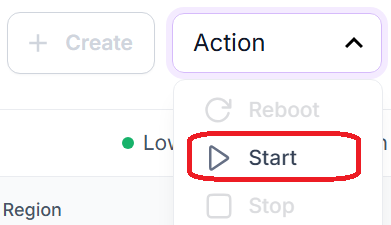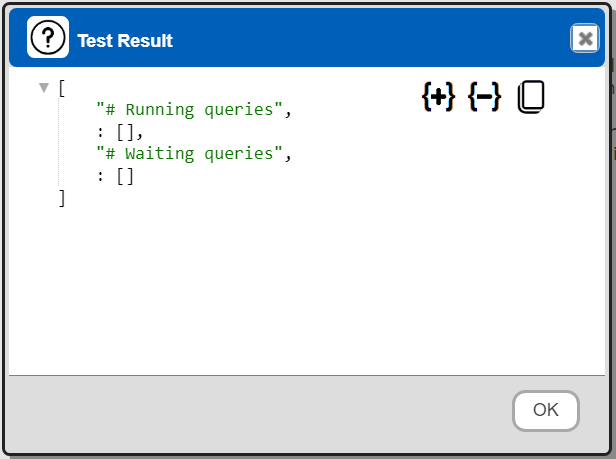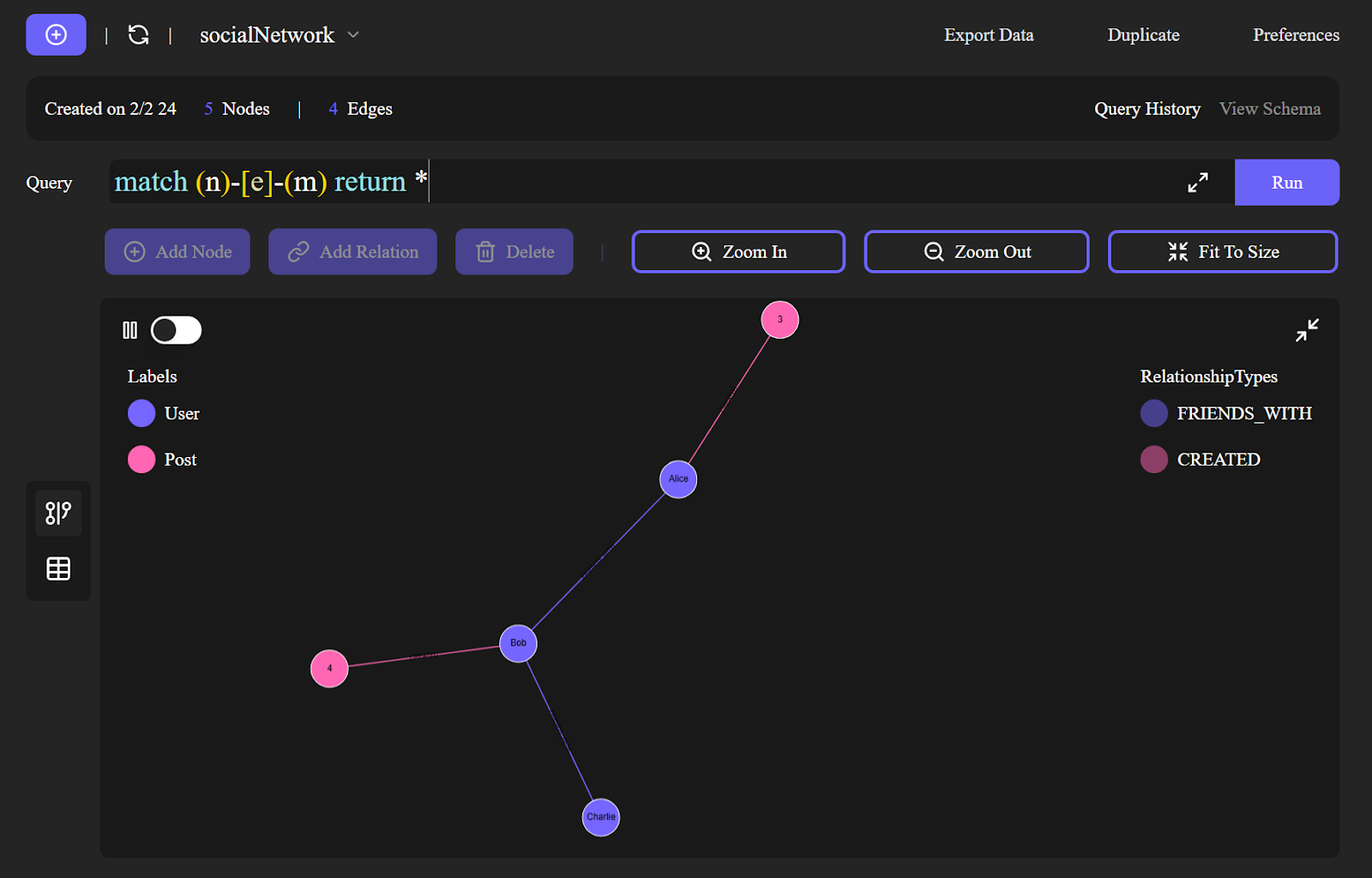FalkorDB
Overview
FalkorDB is a graph database designed to support high-throughput scenarios. It's particularly well-suited for applications involving large language models (LLMs) and knowledge graphs.It uses the Cypher query language for interactions. For more information see https://www.falkordb.com/.
Configuration Information
Qarbine requires the following information from your FalkorDB instance:
- User name and password,
- FalkorDB instance ID, and
- FalkorDB endpoint and port.
Accessing the FalkorDB Console
Sign on to the FalkorDB console at
Identifying an Access Account
Expand the node shown below
Choose
Locate a user which has “Reader” permission and for which you have the password as well.
If necessary create a new user by clicking
and following the instructions.
Verify the Database is Running
Expand the node shown below
Click on the desired database name to see its details and verify it is running.
If so then copy the ID to a temporary location.
Starting a Stopped Database
If you see
then choose the option highlighted below

In the bottom left the following will be shown
the listing is updated as shown below
Wait for it to completely start.
Copy the ID to a temporary location.
Determining the End Point- Option 1
Click on
Click the ID for the instance of interest
Click
Scroll down a bit and copy the endpoint
Store it a temporary location.
Qarbine Configuration
Compute Node Preparation
Determine which compute node service endpoint you want to run this data access from. That URL will go into the Data Service’s Compute URL field. Its form is “https://domain:port/dispatch”. A sample is shown below.
The port number corresponds to a named service endpoint configured on the given target host. For example, the primary compute node usually is set to have a ‘main’ service. That service’s configuration is defined in the ˜./qarbine.service/config/service.main.json file. Inside that file the following driver entry is required
"drivers" :[
. . .
"./driver/falkorDbDriver.js"
]
The relevant configuration file name for non primary (main) Qarbine compute nodes is service.NAME.json. Remember to have well formed JSON syntax or a startup error is likely to occur. If you end up adding that entry then restart the service via the general command line syntax
pm2 restart <service>
For example,
pm2 restart main
or simply
pm2 restart all
Data Service Definition
Open the Administration Tool.
Navigate to the Data Services tab.
A data service defines on what compute node a query will run by default along with the means to reach to target data. The latter includes which native driver to use along with settings corresponding to that driver. Multiple Data Sources can reference a single Data Service. The details of any one Data Service are thus maintained in one spot and not spread out all over the place in each Data Source. The latter is a maintenance and support nightmare.
To begin adding a data service click
Enter a name and optionally a description.
Set the Compute URL field based on the identified compute node above. Its form is “https://domain:port/dispatch”. A sample is shown below.
On the right hand side enter a data service name and description. Also choose the “FalkorDB” driver.
For the server template enter the FalkorDB endpoint with an HTTPS:// prefix.
For the server options enter
user= "THE_USER",
password="THE_PASSWORD"
For example,
There is a comma between the multiple key\value pairs. Strings are enclosed in double quotes
You can reference environment variables using the syntax %NAME%. Any strings should be quoted and the key\value pairs separated by commas.
Optionally set the graph context by entering its name in the generic ‘Database’ field.
Test your settings by clicking on the toolbar image highlighted below.
The result should be TigerGraph version and other information.

Save the Data Service by clicking on the image highlighted below.
The data service will be known at the next log on time. Next, see any FalkorDB query interaction and any tutorial for information on interacting with FalkorDB from Qarbine.
Loading Sample Data
Basic Data
On the Qarbine host within the ˜/qarbine.service/sample folder are files to load sample data.
| File | Description |
|---|---|
| importDb.js | The utility to load the sample data. |
| falkorDb.env | The settings for loading the sample data. |
| myGraphDump.json | The sample data to load. |
SSH into the Qarbine host and navigate to ˜/qarbine.service/sample.
Change the contents of falkorDb.env to match your environment and target graph.
USER = SetToYourUser
PWD = ChangeMe
HOST = 'r-ChangeMeToYourHost.cloud'
PORT = SomeNumber
GRAPH = myImportedGraphName
To import the data run
node importDb.js
Social Network
The following was written up at https://docs.falkordb.com/getting_started.html.
Navigate to the FalkorDB Browser tool https://browser.falkordb.com/graph. The following commands can be used to populate a graph.
CREATE (alice:User {id: 1, name: "Alice", email: "alice@example.com"})
CREATE (bob:User {id: 2, name: "Bob", email: "bob@example.com"})
CREATE (charlie:User {id: 3, name: "Charlie", email: "charlie@example.com"})
CREATE (post1:Post {id: 101, content: "Hello World!", date: 1701388800})
CREATE (post2:Post {id: 102, content: "Graph Databases are awesome!", date: 1701475200})
CREATE (alice)-[:FRIENDS_WITH {since: 1640995200}]->(bob)
CREATE (bob)-[:FRIENDS_WITH {since: 1684108800}]->(charlie)
CREATE (alice)-[:CREATED {time: 1701388800}]->(post1)
CREATE (bob)-[:CREATED {time: 1701475200}]->(post2)
The nodes represent User and Post objects. The relationships connect Users with a FRIENDS_WITH relationship, and Users are connected via a CREATED relationship to Posts.
You can view the graph by running
match (n)-[e]-(m) return *
Shown below is example output.
